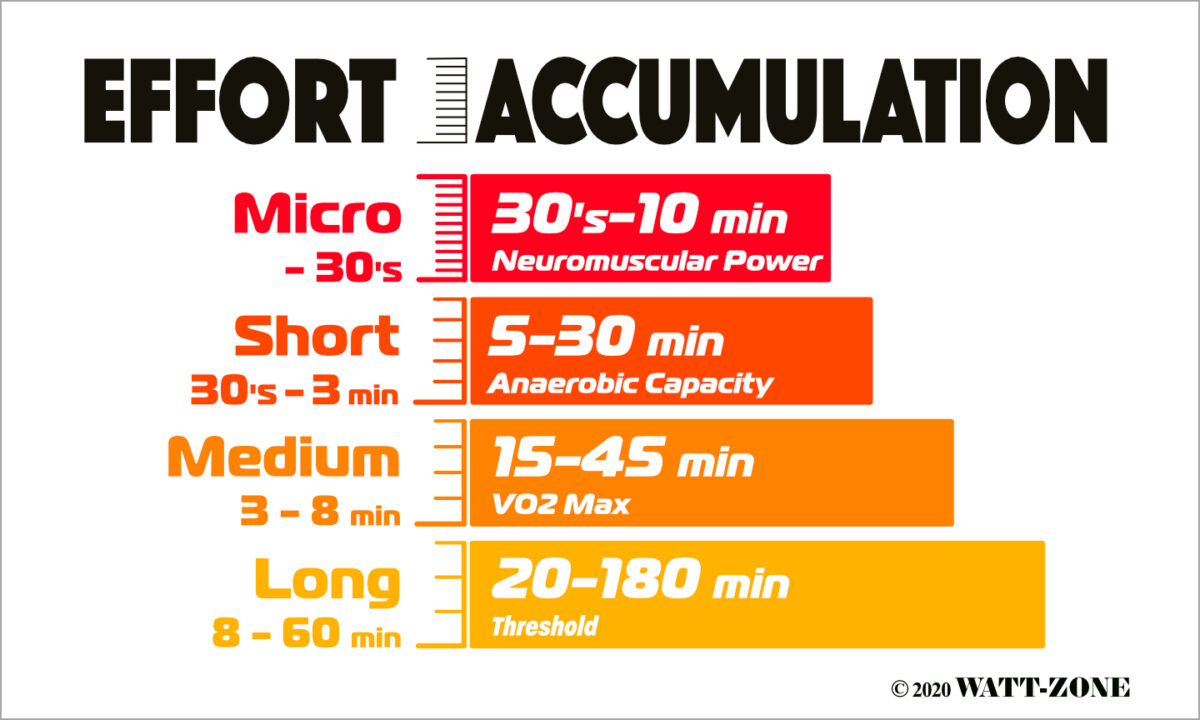Training with Optimal Accumulation is perhaps the most important element in improving one’s cycling. It’s not a new idea, but more often than not it’s an element of training that gets overlooked. Performing the perfect amount of training at Effort {exercise above the Aerobic-Threshold} is a difficult thing to achieve. Not enough training at Effort will yield little to no benefit and too much will cause fitness to stagnate or even deteriorate. The Accumulation model of training provides a simple framework for managing training at Effort.
To Recap, an Accumulation Ride is one of the four REAL Rides a cyclist can do. It is where you train for critical efforts and improving key physiological marks. Consequently, it is where a cyclist shapes their fitness. In this section, we will take a close look at training with Optimal Accumulation – the ideal amount of time at Effort.
At this point, it is important that you have read about Effort Duration or interval length. In short, at Watt-Zone we have split Effort Duration into four distinct categories; Micro, Short, Medium, and Long. These categories reflect the Effort’s ability to optimize Key Physiological Marks: Neuromuscular Power, Anaerobic Capacity, Vo2 Max, or Anaerobic Threshold, respectively.
These Categories correlate to specific Effort Duration Ranges:
- Micro – up to 30 seconds,
- Short – 30 seconds to 3 minutes
- Medium – 3 minutes to 8 minutes
- Long – 8 minutes to 60 minutes
Accumulation Ranges
Furthermore, these Categories have corresponding ranges of Accumulation that have proven to be effective for optimising Neuromuscular Power, Anaerobic Capacity, Vo2 Max, or Anaerobic Threshold respectively.
- Micro – 30 seconds to 10 minutes,
- Short – 5 to 30 minutes,
- Medium – 15 to 45 minutes,
- Long – 20 to 180 minutes,
For example, if you wish to work on Anaerobic Threshold with Long Efforts of 20 minutes. You could do anything from:
- 20 min x 1 for 20 minutes of Accumulation, to
- 20 min x 9 for 180 minutes of Accumulation.
This is of course a big range, and finding the Optimal Accumlation for training takes a few more steps.
Accumulation & Current Fitness
Firstly within these ranges, a cyclist determines their optimal accumulation by acknowledging their current fitness level.
If your training has a good base, and you have been completing structured training at Effort, Accumulation closer to the maximum of the range is appropriate. When your fitness is not as good as it could be, training at the lower end of the range is more appropriate.
As an example:
- 20 min x 1 for 20 minutes of Accumulation for an unfit cyclist, vs
- 20 min x 3 for 60 minutes of Accumulation for a fit cyclist.
Optimal Effort Duration within Category
Secondly, the relative duration of an Effort within a category of Effort Duration also plays a role in determining Optimal Accumulation. Looking at Short Efforts, they can be between 30 seconds and 3 minutes long. If performing longer Effort-Durations (close to 3 minutes) rather than shorter effort durations (close to 30 seconds) it is likely that the Optimal Accumulation for a cyclist should be higher within the specified 5-30 minute range.
As an example:
- 30’s x 10 for 5 minutes of Accumulation, vs
- 3 min x 7 for 21 minutes of Accumulation.
Accumulation influence on overall intensity
One also needs to remember that Accumulation has a huge role to play in determining the overall intensity of a session. Given that Efforts should be repeated at a maximal repeatable intensity. For example, let’s look at performing 5-minute Effort Durations. If a cyclist does 15 minutes of Accumulation (5min x 3) the intensity will be very high. If they do 40 minutes of Accumulation (5 min x 8) ten the overall intensity will be much lower.
A cyclist’s choice of Accumulation may also be governed by the Critical Moments of goal rides. One could face a goal ride that requires multiple 5-minute efforts. Or a goal ride that requires a singular 5-minute effort. These are two very different scenarios, but they both fall into the realm of Medium efforts, and obviously require different training strategies.
If one is not training for any specific goal rides, and focusing on physiological marks. Then having a middle-of-the-road approach, or choosing Accumulation closer to the middle of the specified ranges is appropriate.
Combining
The optimal level of Accumulation is guided by the ranges specified for each category of Effort Duration. Within these ranges by acknowledging;
- the Critical moments of goal rides,
- ones current fitness, and
- the relative duration of an effort within the Effort Duration Category
ones current fitness, cyclists can fine tune their optimal accumulation.
Periodisation
Accumulation should be optimized by the common principles of periodization. Increasing during build weeks and phases. Decreasing in recovery weeks. Also, increasing in blocks of specificity or competition phases.
Simplistically treat Accumulation alike the duration of your long ride. It should increase each week, but not by too much, just 10 to 20 percent. Correspondingly you can also reduce Accumulation during recovery weeks.
For instance, let’s say in a six-week training block at a given “effort-duration”, a cyclist may start at 20 minutes Accumulation for a particular session, and progress to 40 minutes by the 5th week. And then for the 6th week reduce the Accumulation to 25 minutes.
Conclusion

The above graphic puts all the necessary information together for a cyclist to get going developing their Accumulation sessions. All that is left to do is choose which efforts to work on, and be realistic about ones fitness level.
Training with optimal accumulation is perhaps one of the most crucial parts of training to get right. But with a little bit of practice, and careful periodisation. Cyclists can employ Accumulation as a training metric. And see huge gains in fitness.
